 With the recent announcement of Batman and Catwoman’s possible engagement in the comics, the astonishing success of Wonder Woman at the box office, and the outpouring of remembrances upon the death of Adam West, the beloved star who played Batman in the 1960s, there’s no denying that characters in the DC universe play a huge role in pop culture today. Of these characters, Catwoman is arguably one of the most dynamic, and she has remained fiercely independent through her many incarnations over the past 75 years.
With the recent announcement of Batman and Catwoman’s possible engagement in the comics, the astonishing success of Wonder Woman at the box office, and the outpouring of remembrances upon the death of Adam West, the beloved star who played Batman in the 1960s, there’s no denying that characters in the DC universe play a huge role in pop culture today. Of these characters, Catwoman is arguably one of the most dynamic, and she has remained fiercely independent through her many incarnations over the past 75 years.
In The Many Lives of Catwoman: The Felonious History of a Feline Fatale, Tim Hanley, author of Investigating Lois Lane and Wonder Woman Unbound, provides readers with an accessible history of Catwoman, the mercurial icon who headlined her own series for more than 20 years. The Many Lives of Catwoman turns the superhero genre upside down by showing the perspective of not only a villain, but a female villain navigating the male-dominated worlds of Gotham City and comic books. Tim took the time to chat with us about the resilient character’s unique path.
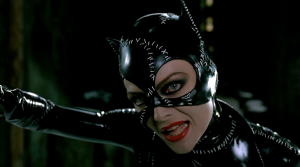 The Many Lives of Catwoman is your third book about a female comic book character. Why Catwoman this time around?
The Many Lives of Catwoman is your third book about a female comic book character. Why Catwoman this time around?
I’ve been a Catwoman fan for as long as I’ve been a comic book nerd. Batman Returns with Michelle Pfeiffer’s Catwoman came out when I was six years old, Batman: The Animated Series followed soon after with Adrienne Barbeau voicing the character, and the old live action Batman television show was on in reruns with Julie Newmar, Lee Meriwether, and Eartha Kitt’s fantastic Catwomen. They were all different but all amazing, and they made me a huge fan of the character. So when I started writing comic book history, Catwoman was always in the back of my mind as a potential subject. While Wonder Woman and Lois Lane are very different characters with distinctive stories, they’re both heroines and their journeys follow the broad strokes of women’s history in America. Catwoman is the opposite; she’s a villain, and her history is chock full of unique twists and turns. For my third book, I thought it would be fun to mix things up and explore the world of comic books and women in popular culture through the villainous lens of Catwoman.
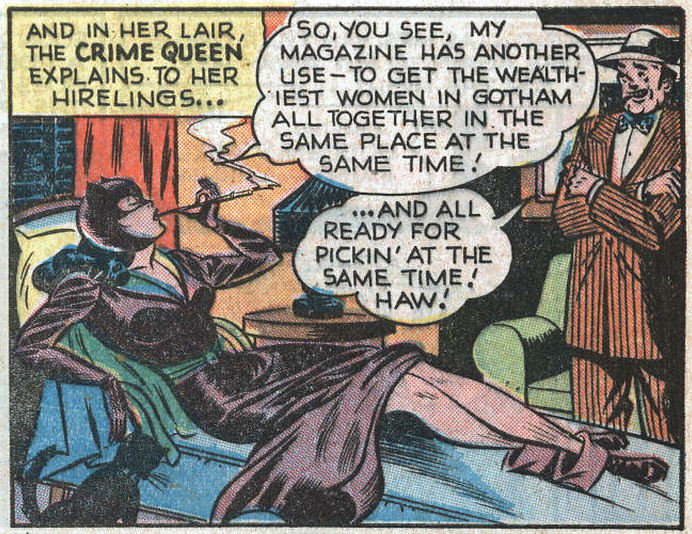 In what ways is Catwoman’s history different from what we saw with Wonder Woman and Lois Lane?
In what ways is Catwoman’s history different from what we saw with Wonder Woman and Lois Lane?
Catwoman’s role as a villain made her a perpetual outsider, for good and ill. In the 1940s, Catwoman was supposed to serve as a cautionary contrast to the moral fortitude of characters like Wonder Woman and Lois. She was a thief who used her feminine wiles to her advantage and was thus meant to be seen in a bad light, but she actually came off as a clever, independent woman who was having a blast living on the wrong side of the law. This freewheeling, fun nature stayed with the character throughout the decades, and often helped her avoid the pitfalls of less empowered eras for women in the superhero genre. At the same time, though, being a villain made Catwoman more susceptible to sexualized depictions and roles (invariably written and drawn by male creators) that would have been considered over the line for heroines. Plus, as an outsider, she was subject to lengthy absences when these depictions got too dark or her traits became undesirable.
What kind of research went into tracking these ups and downs? It sounds like there are a lot of different versions of Catwoman to cover!
Yeah, between these absences and the different roles she’s taken on, Catwoman has been revamped several times in the comics over the years. And I’ve read all of them! The book covers every comic book incarnation of the character, from her first appearance in 1940 all the way through to the present day. I turned in the book last year and we added new developments with each round of edits, so we’re as up to date with the comics as we can possibly be. We also dig into all of Catwoman’s appearances in other media, from the seven women who have played live action versions of the character on the big and small screen to all of her animated outings to video games and more. It’s thorough, but all situated within a broader framework of the overall evolution of the character.
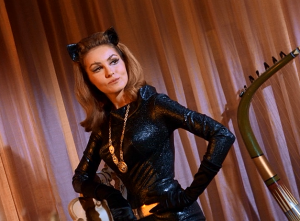 Do you have a favorite incarnation of the character among all these different Catwomen?
Do you have a favorite incarnation of the character among all these different Catwomen?
I love them all, really. Each of them is special and fascinating in their own way, even Halle Berry’s take on her in the truly appalling 2004 Catwoman film. I am especially fond of Julie Newmar, though; her Catwoman’s commitment to total villainy despite her romantic interest in Batman was played perfectly, and she embraced the campy dialogue and aesthetic wholeheartedly. Michelle Pfeiffer’s Catwoman in Batman Returns is remarkable as well. She stole the movie with an absolutely electric performance, and Pfeiffer’s commitment to the role was really quite impressive, especially once you know what went into it behind the scenes. In the comic books, I love late 1940s Catwoman, when she embraced her supervillain role and planned crafty, elaborate heists with clever themes and twists. She was wonderful in the early 2000s too, with books like Jeph Loeb and Tim Sale’s Batman: The Long Halloween and Batman: Dark Victory that explored her early years as a socialite/thief, along with Ed Brubaker’s run on her eponymous series (with several artists, including Darwyn Cooke and Cameron Stewart) that returned Catwoman to her roots and fleshed out her world in new, compelling ways.
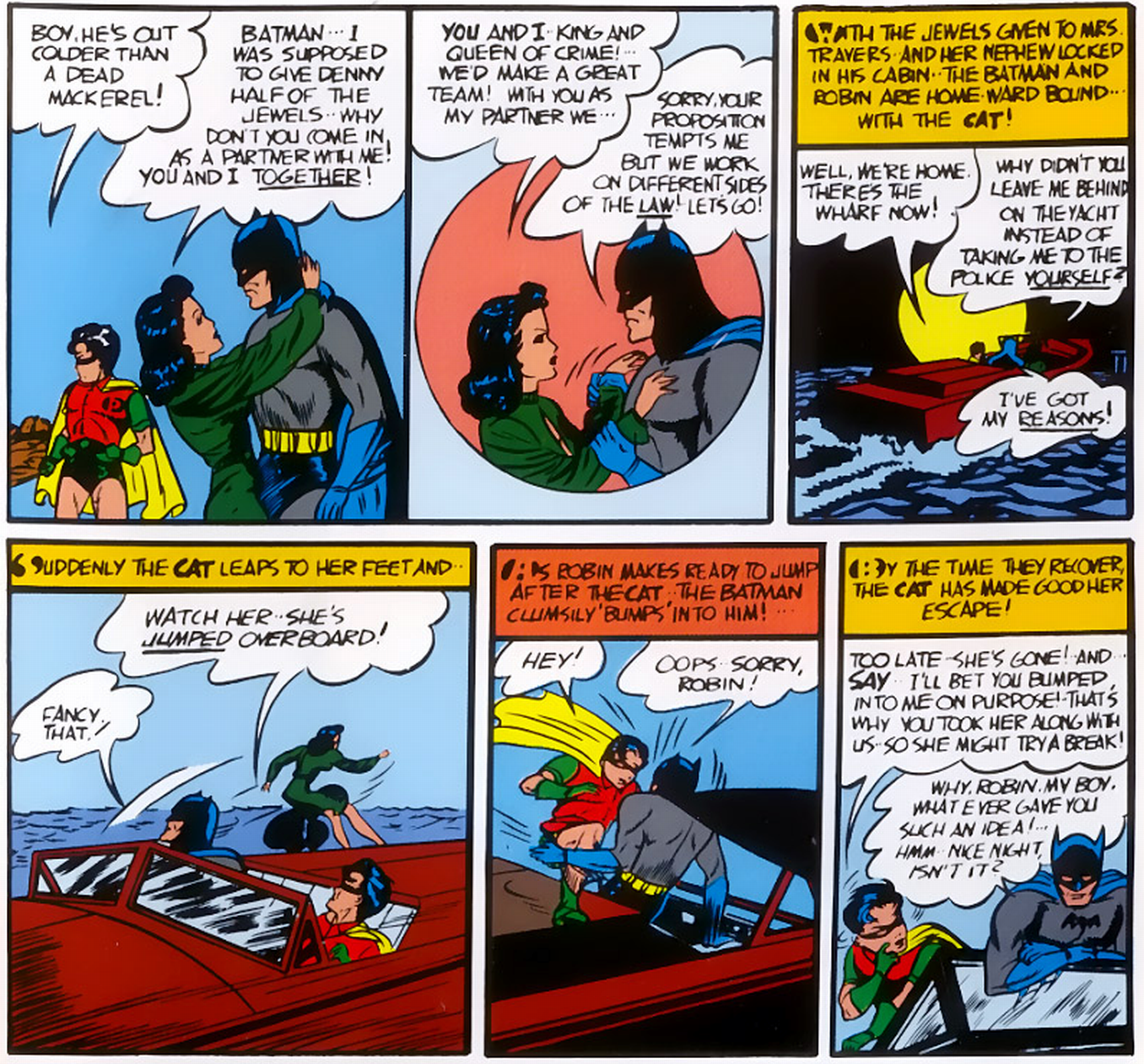 Catwoman is best known as a Batman villain, and as you mentioned there’s often been a romantic element to their relationship. How has this evolved, and how does Batman play into the book?
Catwoman is best known as a Batman villain, and as you mentioned there’s often been a romantic element to their relationship. How has this evolved, and how does Batman play into the book?
The star of the book is Catwoman, full stop, but Batman certainly comes up a lot since she spends most of her time going toe-to-toe with him. Romance has been part of their relationship from Catwoman’s very first appearance, in which she so enraptured Batman that he let her escape and even stopped Robin from going after her, to Robin’s great consternation. She’s Batman’s Kryptonite in a certain way, one of the only people who can get him to sway at all from his commitment to crimefighting. The nature of their relationship has changed a lot over the decades. In the comics, they were flirtatious in the 1940s and 1950s, more at odds in the 1960s and 1970s, dated in the 1980s, largely stayed apart in the 1990s, dated again in the 2000s, and Batman actually just proposed to Catwoman in the comics last week (no word yet on her response!). Adaptations tend to focus on the romantic side of things, with nearly every live action or animated incarnation of the character involved with Batman in some way. But more often than not, it’s Catwoman who has the upper hand. She likes Batman, but she really likes to steal, and that inclination tends to come first for her.
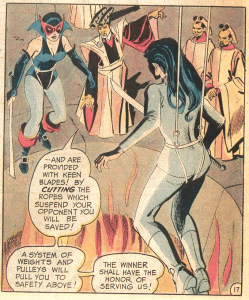 With the Wonder Woman movie now a box office sensation, should we be expecting to see Catwoman on the big screen anytime soon? And have Wonder Woman and Catwoman had much interaction of the years?
With the Wonder Woman movie now a box office sensation, should we be expecting to see Catwoman on the big screen anytime soon? And have Wonder Woman and Catwoman had much interaction of the years?
While the details are vague thus far, Warner Bros. is developing a Suicide Squad spinoff movie starring Margot Robbie’s Harley Quinn that’s going to be titled Gotham City Sirens. In the comics, this team is typically Harley Quinn, Poison Ivy, and Catwoman. So yes, we could be getting another cinematic Catwoman very soon. Also, the setup of DC’s cinematic universe could give us something a little bit different; Batman is much older than usual and further along in his career in the movies, so we might get an older, more experienced Catwoman, which could be cool. And of course, we’ve got a very young live action Catwoman right now with Camren Bicondova’s excellent Selina Kyle in Gotham on Fox.
In terms of Catwoman’s past connections with Wonder Woman, they haven’t crossed paths often, but there was one notable team up in 1972. Both women were in an odd spot: Wonder Woman was in the midst of her mod era, in which she gave up her superpowers and became a globetrotting karate master. Catwoman on the outs in Batman comics as they tried to move away from the camp of the television show. The two women were searching for the same ancient artifact when they met up in East Asia, and after they were captured by monks and forced to fight to the deaths, they teamed up to defeat their captors and then journeyed into a different, mystical direction. It was all very odd, but also very fun and a fascinating moment in the bizarre histories of both characters.
Follow Tim on Twitter (@timhanley01) and Tumblr for more Catwoman, Lois Lane and Wonder Woman trivia.
“Feed your kitty now, because once you start reading, you won’t be able to stop. Tim’s words are as mesmerizing as Catwoman herself.” —Adrienne Barbeau, actress and voice of Catwoman in Batman: The Animated Series, and author of There Are Worse Things I Could Do
“Tim Hanley has done it again! His comprehensive history of Catwoman is as engaging and enlightening as his masterworks on Wonder Woman and Lois Lane. As in his previous books, Hanley walks us from Catwoman’s on-paper origin through her myriad film and TV incarnations to her modern place in comic books, pulling on cultural and political threads to reveal what makes the world’s most famous femme fatale a truly unique feminist hero. Catwoman has outlasted the male artists and writers who have perpetually denied her agency and projected their sexual fantasies onto her. In Hanley, she finds a writer who finally succeeds in honoring her voice.” —Heather Hogan, senior editor, Autostraddle
The Many Lives of Catwoman: The Felonious History of a Feline Fatale by Tim Hanley lands on shelves July 1, 2017 and is available wherever books and e-books are sold.
No Comments
No comments yet.